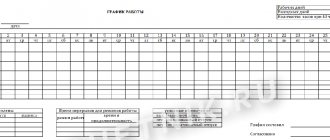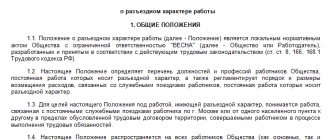In the article we will analyze what it is - a shift method or work schedule, what it is, and we will tell you everything about it. For most employees, this is a good way to earn more, and for employers, it is an opportunity to provide remote sites with staff on a permanent basis. This is how research and expeditions are carried out, and areas of industry and production are developed. This is a traditional form of the labor process in areas of activity where it is impossible to ensure the movement of workers from workshop to home on a daily basis. This includes logging and gas or oil production. People stay for some time right at the plant in dormitories. It remains to figure out how it functions.
How to understand the shift work method, what it is
This is the name for permanent or shifting (seasonal) activity, where people do not return home during the day, but rest on the territory of the organization in specially designated places.
This is a specific form of labor relations, therefore separate acts have been thought out for it, which we will discuss below.
A company can introduce a similar type for certain specialties, people, or for all its employees at once. For example, if a company is located in a sparsely populated region, then it is better to recruit managers and specialized professionals for shifts. So they will be constantly in production.
If workers have to travel to and from work every day for more than 3 hours every day, then it is better to prepare an order and invite them to work on a shift basis.
Most often this is practiced in areas of the Far North and equivalent areas, as well as in areas where it is necessary to quickly erect a new workshop, open an enterprise or build a building.
The main challenge of the approach is the need for a large amount of labor. Despite the fact that such work is paid more expensively and requires more effort and money to set up, companies are willing to do it. Because the result and an established production process are much more important. For example, in the oil industry and when constructing bridges, it is important to comply with all technological and time standards.
How to register employees according to the Labor Code of the Russian Federation
To hire an employee on a rotational basis, you need to:
Step 1. Provide a medical examination at the employer’s expense.
Step 2. Conclude an employment contract, indicating in it:
- place of work with the address of the facilities where the shift is taking place;
- the fact of hiring an employee on shift;
- working hours;
- the duration of additional leave if the activity is carried out in the Far North and equivalent zones.
Step 3. Issue an order for acceptance, indicating in it that the work will be on a rotational basis, and the place where the shift workers will gather.
Step 4. When filling out a work book, indicate that your work activity is organized on a rotational basis.
Regulation by law
Every person, before he finds a job under such conditions, should understand how this is reflected in the Labor Code of the Russian Federation.
Article 297 clearly states that this can be called a type of activity in which a specialist cannot return to his place of registration every day. This type cannot be classified as business trips, since a shift is considered to be working all the time, including rest between shifts and part of the day at work.
It should not last more than 1 month, but in special cases and by prior agreement, the employer can increase this period. Shift is no more than 12 hours, if more, then this is overtime, which is paid separately. The order in which shifts will take place is also determined in advance by management and specified in the documentation that the employee will sign.
Weekends during a shift are days off that are either paid according to special rules or counted towards the period when the employee will be at home. There are no holidays or vacations at the facility; rest begins only when a person gets to their place of residence.
What is working on a shift basis: what does it mean according to the Labor Code of the Russian Federation
This is a special form of the labor process, which is based on the inability to get home every day. The company undertakes to organize the transportation of people in both directions, to provide conditions for livelihoods and accommodation at the plant or near the production site.
Company order
Before making such a decision, an enterprise usually carries out calculations that help to understand how effective and expedient it is to move to this type of interaction with personnel.
If this should pay for itself, then the administration creates a document according to which it completely switches to this type or introduces it as an additional one.
The papers state:
- the fact that the company now has a similar variety;
- how time will be counted;
- for what period is it summed up;
- terms of payment;
- the level of the bonus, if there is one - in government institutions this is regulated by law;
- coefficients by region;
- “northern” allowances, if the organization is located in the relevant region;
- how long the shift is, how many days to work and rest;
- Mandatory - signatures of all employees who have read the document.
How to introduce it at the enterprise
The Labor Code of the Russian Federation in Chapter 47 explains the algorithm for introducing exhaust at an enterprise. To do this, a number of steps are taken:
Step 1. Make a decision. This is done by the management of the organization based on:
- technical and economic calculations;
- calculating the effectiveness of the algorithm.
Step 2. Reflect the calculations in special design and technological documents. They are the basis for forming a conclusion about the advisability of using the rotation method.
Step 3. Develop an administrative document for the enterprise. It needs to reflect:
- the date of introduction of the new system in the organization;
- algorithm for settlements with employees taking into account the use of accumulated labor time;
- terms of payment, duration;
- schedule as an appendix to the document.
Step 4. Agree on the method and order with the trade union:
- by sending the project to the trade union;
- having received a motivated written review no later than 5 working days.
Step 5. Approve the agreed order. It is imperative that all employees affected by the new work schedule be familiarized with it.
Which companies can use this method?
More often than others, it is used by those who open enterprises in the regions of the North and areas related to them. But in recent years it has been actively used in “ordinary” areas, because in the Labor Code there are no restrictions on areas, and the delivery time can be significantly reduced.
The main condition is the presence of an object, which is inconvenient to get to due to its remoteness or lack of roads. If a specialist has to travel more than 3 hours each time, then it is advisable to offer him a shift.
Sometimes the tax service tries to challenge the legality of its use, but usually the court sides with the employers.
Why is this not a business trip?
Sometimes personnel services confuse shift work with travel, but there are differences:
- Payment. A seconded specialist’s salary will include a working day and small tariff allowances. The shift worker draws up a special document in which all tariffs, terms and conditions are prescribed. Workers are considered to work full days.
- Body check. Before going to another city for a couple of days, you will not need to undergo an examination and confirm your health.
- Deadlines. There are no restrictions on weeks of stay for a business traveler. Upon his return, he goes to work. If people go to development, then they cannot be there for more than 1-3 months, after which a rest period follows.
- Goals. People go on a business trip to fulfill a specific assignment - to increase sales, to launch a line. The rotation method simply involves a regular 12-hour shift.
Do you want to implement “Store 15”? Get all the necessary information from a specialist.
Thank you!
Thank you, your application has been accepted.
How to register 3 “shift” types of time in ZUP
The situation is simplest with working types of time for shift workers - these are day and night (sometimes evening, if such records are kept) work hours. They are simply planned in Employee Work Schedule (Settings - Employee Work Schedules). An example of such a setting is discussed in the article Shift - setting up payment for time worked.
As for inter-shift rest , the first thing that comes to mind is to also provide for them immediately in the Employee Work Schedule . To do this, you should make a full calculation of overtime for the whole year and enter MO manually in the Schedule . However, in reality this option can be used in rare cases. The main disadvantages of this method of accounting for days of inter-shift rest :
- If during the year there are any changes in the rotation schedule or a delay in travel, you will have to recalculate and correct the MO into the schedule. For example, in January, employees will be delayed on the road by 3 days, as a result, the provision of inter-shift rest will shift by 3 days. Moreover, such changes can affect several months, and sometimes the entire period until the end of the year.
- If an employee is hired or transferred to a “shift” position during the year, the calculation of inter-shift rest may not be suitable for him. Then you will have to adjust the MO using the Individual Schedule .
- If an employee is sick or goes on vacation, his actual hours worked do not coincide with the schedule. In this case, the calculation of inter-shift rest and the procedure for their provision may change. Then again manual adjustments will be required, which can take several months.
- MO days into the Employee Work Schedule is done manually. Therefore, if you need to refill the Employee Work Schedule , all manual edits with data on inter-shift rest will be overwritten.
For the reasons stated above, it is better to calculate the provided days of inter-shift rest on a monthly basis. You can enter information about them into the program using time tracking documents: Timesheet , Individual schedule or Data for salary calculation . inter-shift rest days is discussed in more detail in the article Accounting and payment for inter-shift rest.
As for Days on the road and Weekends on shift , you can act in different ways. It all depends on the initial accounting conditions. The table provides a comparative description of the options for recording these types of time:
| Comparison criteria | Travel days (DT) | Weekends on shift (BB) | ||
| Indicated in the schedule | Entered through Payroll Data, Timesheet or Individual Schedule | Indicated in the schedule | Time type is not used | |
| Ease of entry into the program | + | You will need to manually fill out time information in documents | + | It will be necessary to assign a shift allowance using pay change documents separately for each shift period |
| Versatility of use | Any violation of the schedule (for example, a delay in transit) will still require manual adjustments | Data is entered monthly in fact, so it is always up to date | Does not solve all possible problems of accounting for shift allowance (for example, illness of an employee at the place where work is performed during the shift period) | Allows you to take into account all possible situations for calculating shift allowance |
| Calculation of an employee's payroll when paying by ChTS | Payment for travel days will be taken into account in the employee’s payroll amount | Payment for travel days will NOT be taken into account in the employee’s payroll amount | Error! Weekends on shift will increase the payroll amount | The payroll will be calculated correctly, without taking into account days off on duty |
| Display in the timesheet | Increase the number of working hours (can be bypassed, but will complicate the work) | Increase the number of working hours (can be bypassed, but will complicate the work) | Increase the number of working hours (can be bypassed, but will complicate the work) | The number of working hours does not increase |
| Automation of calculation and storage of the remaining hours of MO | Overtime will be calculated incorrectly (you can bypass it, but it will complicate the work. A workaround option is in the article Accounting and payment for inter-shift rest, Example 3) | Correct calculation of overtime (discussed in the article Accounting and payment for inter-shift rest, Example 2) | Overtime will be calculated incorrectly (you can bypass it, but it will complicate the work. A workaround option is in the article Accounting and payment for inter-shift rest, Example 3) | Correct calculation of overtime (discussed in the article Accounting and payment for inter-shift rest, Example 2) |
| Links to configuration example | Payment of travel days for shift workers, Method 1. Reflection of travel days in the employee’s schedule | Payment of travel days for shift workers, Method 2. Reflection of travel days in separate documents | Setting up an allowance for a shift method, Method 1. Setting up a shift allowance using the “Weekends on shift” time type | Setting up an allowance for a shift method, Method 2. Setting up a shift allowance without using additional types of time |
Shift: what kind of schedule is this, what does it mean - working conditions
This type of employment is beneficial not only to workers, but also to the enterprise. But it's important to understand that for people it involves daily, often strenuous physical activity for a certain number of days in a row. Sometimes this is a deterioration in the usual lifestyle and distance from home and family. Not everyone can do this, which is why most companies limit their hiring to men. But these are not the only restrictions. Let's look at this issue in more detail.
Who has the right to work
There are two important factors according to which applicants are selected for each position - profession and physical health. Often the shift is located in places remote from the city and populated areas. Therefore, a person with chronic diseases should not go to the Far North.
Determines whether you can go to work, doctor. He also issues the appropriate certificate for the employer. Which doctors will have to be visited regularly between shifts is determined by the enterprise and the direction of its activities. This is enshrined in local acts.
Restrictions
There are several categories of people for whom this type of activity is unacceptable:
- pregnant and lactating women;
- guardians or parents of at least three children - one of the adults must remain with the wards;
- persons under 18 years of age;
- those who have not undergone a medical examination for any reason.
How to organize a rest and work schedule
Here time is calculated differently. The entire period is taken into account from the moment a person boards the train heading to the object until the day he returns home. A working day does not exceed 12 hours, unless otherwise specified in the contract. One employee cannot be assigned two shifts in a row.
The interval between shifts is called inter-shift. The employee spends it outside the company and is paid like a standard vacation.
What does a full cycle look like?
To take into account everything that needs to be reflected in the calculation sheet, you need to calculate:
- hours and days that a person will get to the object and back;
- moments spent directly on performing direct duties;
- weeks of inter-shift rest.
To automate and optimize production processes, we recommend using special software from Cleverence, with which you can effectively organize the work activities of an enterprise.
Let's sum it up
- The work schedule drawn up under the rotation method contributes to a clear organization of work, allows it to reflect all the features of working time and rest time, and makes it possible to assess the volume of payments to each specific employee.
- Mandatory reflection in the schedule requires days of work, days of rest and days spent traveling to / from the place of work. It is advisable to compile it for the period selected as the accounting period for the summarized accounting.
- The work schedule does not have a set form. As its basis, you can take part of the table reflecting the days of the month from the working time sheet, adding columns to it for the necessary information (for example, for the employee’s signature on familiarization).
What does a shift method or work schedule mean, like this
In order to normalize time and provide the company with specialists at every moment, you will have to create a special output sheet, where all activity cycles will be entered. All shifts and specific people who will go out are registered, indicating the hours. The document also states the inter-shift rest and the period required for the journey. The manager is responsible for its preparation and maintenance.
Such a paper is placed in the room where the whole team gathers, for example, in the dining room or locker room, so that everyone can remind themselves what time they should start.
Peculiarities of working on a rotational basis: shift duration
As we said above, in the standard case it does not exceed 12 hours. But for individual positions and individuals it is different. In addition, technological breaks and lunch must be included in this period.
It is prohibited to work for more than 24 hours; a person must be given the opportunity to rest after this.
The company sets the total occupancy time at each site independently. By law it is 15, 30 or 60 days.
The rest of the day after the end of work duties is considered rest, but the employee continues to remain on the employer’s premises. He will only travel between shifts.
Assigning a schedule for the rotation method
Shift work is used when the place of work is so remote from the place where the workers live that daily transportation to/from the place of work becomes impractical. Therefore, workers are taken to the place of work, and they live and work there for a certain time (called a shift) (usually devoting more time to work than under normal conditions). Then they go home to rest, using all the days off they are entitled to during their work, and another shift comes to replace them.
This mode is most often used in continuous production and requires a very clear organization of work. The main role in this organization is played by the work schedule, which is drawn up both by shift and separately for each shift worker involved in the corresponding shift.
Individual scheduling for workers is a necessity, since this document must take into account not only their rest time after a shift, but also the periods they are on regular vacations, which does not in any way affect the shift schedule, but requires the selection of a replacement for the resting employee. At the same time, it is advisable to combine schedules for workers on the same shift into single documents.
The remoteness of the place of work requires that the schedule reflect not only periods of work and rest, but also the days allocated for delivery to/from the place of work. The peculiarity of these days is that they may or may not be included in the number of days of inter-shift rest.
How is it paid?
This method of work should be distinguished from the standard one, as there are some differences. Additional allowances are paid, tickets are provided to get to and from the site on holiday, and accommodation is provided if this is not provided. It is taxed in the same way as any other income.
There are several types of remuneration systems:
- piecework;
- hourly;
- tariff;
- salary
Bonuses are also paid for achievements, delivery of a separate section or for a completed stage.
Summarized time tracking
This indicator is used if the day or week is not standardized and it turns out to be too difficult to calculate. In this case, the schedule includes a certain number of hours worked for the required period from a day to a year. Paid upon actual payment for the period of time taken into account.
Rules for scheduling work on shifts
The schedule should be drawn up in advance, coordinated with the trade union body and brought to the attention of the employee no later than 2 months before the start of application (Article 301 of the Labor Code of the Russian Federation).
Decree of the State Labor Committee of the USSR, the Secretariat of the All-Union Central Council of Trade Unions, the USSR Ministry of Health dated December 31, 1987 No. 794/33-82 (clause 4.2) recommends creating this document immediately for a year, although its creation within the framework of the accounting period used in the summarized assessment of labor time and rest (it can be equal to a month, a quarter or more months, but not more than 12).
The following days must be reflected in the chart:
- work;
- days off provided at the workplace;
- delivery to/from the place of work;
- inter-shift rest.
Staff benefits and tariffs
We have given simple explanations of what it is to work on a free shift. Now let's dwell on the nuances of bonuses and allowances for harmfulness/“northern”.
In accordance with the law, employees can be paid extra from the budget (federal or regional) or from the management of a private company. The reason for the accrual may be laws and acts of the state or a specific enterprise. For example, in Siberia and the Far East they can pay up to 30% of the already accrued wages.
If the working hours are irregular
By law, the employer is not required to pay extra. Some companies calculate it as overtime, but more often the hours are simply added to paid leave. What will be outside the norm and how this will be compensated must be agreed upon with the staff.
If working conditions are difficult
Everyone who works in the Far North or neighboring regions is paid a bonus; it is considered in isolation from the regime in which the worker serves. The order of the Labor Code is established and regulated.
Additional leave
Everyone who works in this way has the right not only to annual rest. If they are in a region that can be equated to Siberia, 16 calendar days are added.
Do you want to implement Warehouse 15? Get all the necessary information from a specialist.
Thank you!
Thank you, your application has been accepted!
Payroll
Payment for shift work is carried out in different ways:
- piecework, charged for a certain amount of work, indicating prices by type of work
- time-based, accrued for the number of hours worked and depends on the tariff rate and category of the employee
- for engineering, technical and maintenance personnel - for the time actually worked based on the official salary or rate.
In addition to the basic salary, bonuses and material incentives are provided for shift workers, the amounts of which and the conditions for receipt are determined by the Collective Agreement or regulations on bonuses.
The basic provisions on working on a rotational basis clearly define the amounts of allowances, compensation and various additional payments associated with working conditions that differ from normal ones. The organization chooses the payment system independently and stipulates the terms of payment in the employment contract.
For workers engaged in rotational work, including employees of organizations and food and trade enterprises, medical institutions, transport and communications, regional coefficients are applied: northern, desert, waterless, highland. The coefficients are applied to the basic salary in accordance with the current regulations in the given territory.
How do they pay for shift shifts?
Since all the time that a person is at the enterprise, in some cases it can be considered irregular, it is important to compensate for it. Therefore, the personnel department must act according to the algorithm when making calculations:
- how long it was necessary to work normally;
- actual quantity according to schedule;
- the standard, processing or deficiency is determined by law;
- the volume of working days that the company is obliged to pay staff is established;
- excess hours are converted into a tariff rate or calculated based on salary.
Advantages and disadvantages
This variety has its positive and negative sides. Advantages:
- excellent pay and earnings;
- you can find a position in another region, even if there is nowhere to work in your own;
- there is a long rest between two trips;
- there is a higher probability of gaining knowledge and unusual experience, since you are always in a state of immersion in tasks at the site;
- free accommodation and often meals;
- There is an opportunity to take a break from gadgets.
But there are also disadvantages:
- usually hard work in remote regions;
- the whole team is nearby, it’s difficult to be alone, you have to stay in the same area with them for a long time;
- long daily working hours;
- not all specialties are in demand;
- having to live far from home, family and friends;
- living conditions are often camp;
- it is impossible to exclude the possibility of fraud by the employer.









